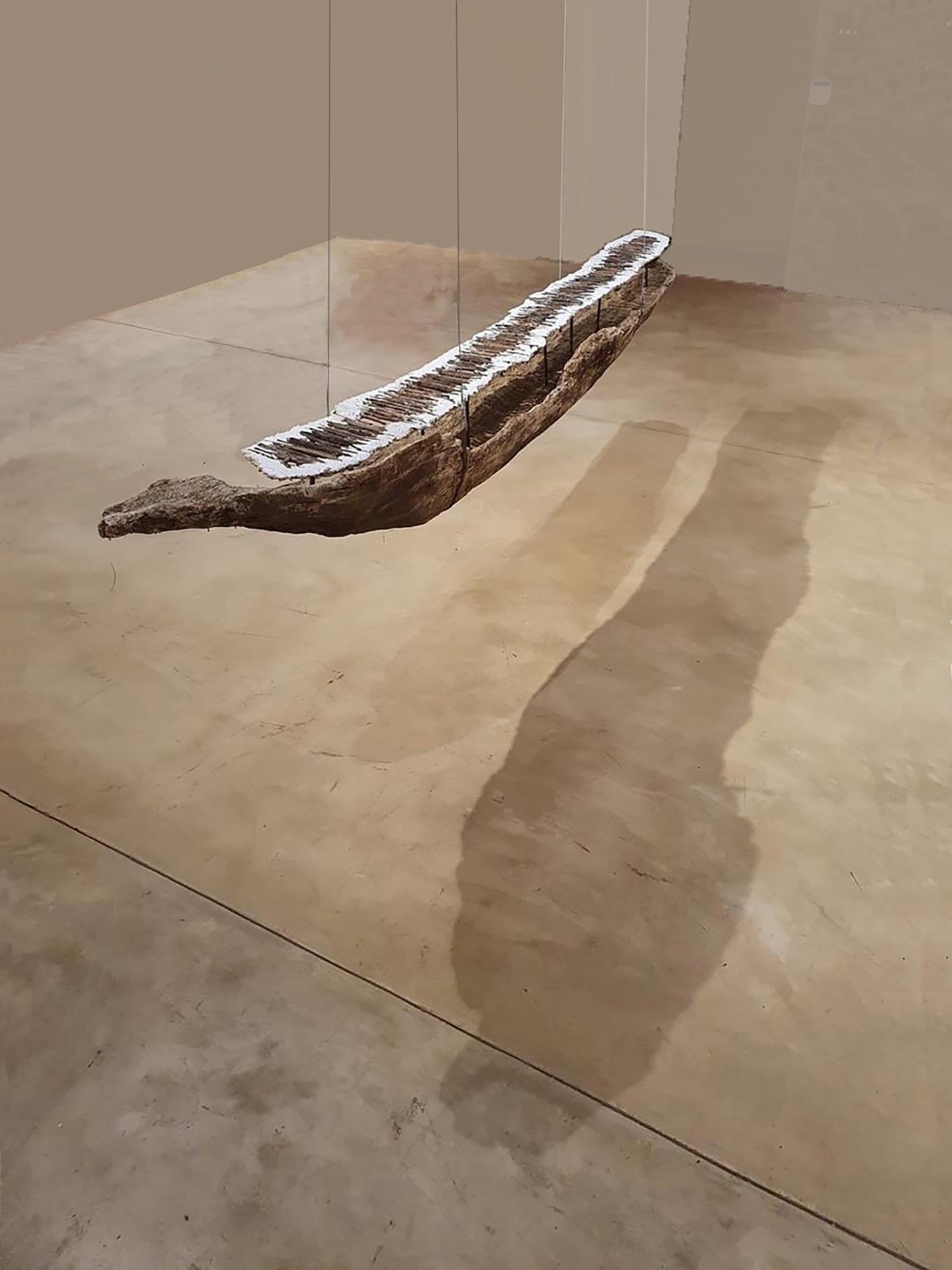

Boat installations by Emma
Willemse
“Willemse’s evocative use of the boat – a vehicle that embodies a crossing along a fathomless watery deep – is physically and psychically apposite. A figure for traversal and displacement – consider the ‘boat people’ then and now, trapped between worlds, one dying, the other powerless to be born, to quote Matthew Arnold – the boat exemplifies human precarity. That Willemse conceives of the boat as a physical and psychological ‘motif’, pertaining to both the conscious and unconscious realm, reveals the degree to which the artist has densified the human condition.”
Ashraf Jamal (2025): Stoicism and Vulnerability – Art as Praise-song, MOL 048, Art Times (https://arttimes.co.za/stoicism-andvulnerability-art-as-praise-song-ingrid-bolton-and-emma-willemse/)
Front page: Emma Willemse, Suture (2018). Wood, mutton cloth stained with Eucaluptus bark ink, string, paper and steel cables. 400 x 100 x 76cm. Installation view at 1:54 African Art Fair, London. Collection: Spier.
Boat installations
A selection of suspended boat-like installations by
Emma Willemse
This catalogue contains documentation of some of the boat-like installations that I have created during the last twelve years. These installations have been part of a continued investigation of the motif of the boat and the meanings it generates in the context of displacement.
I am interested in how the boat, as a means of displacement, can be a metaphor for the traumatic experience of loss.
Travelling over water, which is a symbol of the unconscious, a boat has connotations of a safe container transporting the psyche over the treacherous waters of the unknown. However, the boats that I am creating in my art practice are all rendered impotent through their brokenness, implying the woundedness of the psyche of the displaced.

Emma Willemse, de(part) (2013). Discarded parquet floor blocks, steel wire. 410 x 120 x 75 cm.
Collection: Nando’s, Johannesburg.
The most recent boat-installations are constructed from fragments of makoros (canoes dug out from the trunks of trees) that were found on a Free State farm, where they were used as decorative plant containers. It was a poignant find if it is considered that its ancestor, the Dufuna Canoe, found in Nigeria and excavated in 1994, was carbon dated as 8000 years old. The Dufuna canoe is concrete evidence of ancient transportation over waterways and seas, evoking a gentler way of life using indigenous knowledge systems.
The
found dugout canoes in my work serve as powerful symbols of navigation and journey.
Once vessels of survival and trade, the decayed fragments of the canoes now embody the stories and histories of the cultures they represent. By repurposing these canoes using a range of papermaking techniques, I seek to highlight the transformative power of materials and the knowledge imbedded in them.

Emma Willemse, Incision (2019). Found wooden dugout canoe, mutton cloth, eucalyptus bark, steel cable, 390cm long x 50cm high x 68cm wide. Installation view at Union House, Cape Town.
In the White Paper Boat, the makoro is overloaded with A4 size handmade paper sheets, juxtaposing a remnant of an ancient way of living with vestiges of colonialism and bureaucracy. My aim is to suggest the tragedy of a loss of tradition and culture.
‘White Paper’ refers to the official document issued by authorities or governments to outline policies. The title is used in an ironic way here, indicating the overbearing nature of bureaucracy.

Emma Willemse, The White Paper Boat (2024). Found dugout canoe, found antique printing press, handmade paper, steel cable, 265 x 40 x 75cm.

Emma Willemse, The White Paper Boat (detail) (2024). Found dugout canoe, found antique printing press, handmade paper, steel cable, 265 x 40 x 75cm.

Emma Willemse, The White Paper Boat (detail) (2024). Found dugout canoe, found antique printing press, handmade paper, steel cable, 265 x 40 x 75cm.
The
Wake alludes to the numerous myths, legends and rituals imbedded in several cultures, in which the boat signifies the journey
to the afterlife.
The Wake juxtaposes a decayed dugout canoe with a paper pulp drawing on scrim fabric, which was created by closely observing the wood remnant. The semi-transparent ghost-like drawing hovers over the wooden piece like a trace, suggesting a spiritual journey of remembrance or reverence.

Emma Willemse, The Wake (2024). Found remnant of a dug-out canoe, paper pulp drawing on scrim, 310 x 40 x 90cm.
The title of the work has a dual reference.
The wake of a boat is the pattern of the waves and disturbed water formed by the boat as it displaces the water by moving through it.
A wake is also referring to a vigil, a ritual held beside the body of someone who has died.
In this sense, it could be said that the fragile paper pulp drawing in The Wake is keeping a vigil for the decayed and ‘deceased’ makoro.

Emma Willemse, The Wake (detail) (2024). Found remnant of a dug-out canoe, paper pulp drawing on scrim, 310 x 40 x 90cm.
A raft has connotations to a hastily constructed, makeshift canoe or boat, usually assembled as a rescue vehicle after a disaster. In my version, a fragment of a dug-out canoe is carrying rows and rows of sticks, held together with paper pulp.

Emma Willemse, The Raft (2024). Found remnant of a dugout canoe, paper pulp, wooden stick, 315 x 30 x 51cm.


This page: The Raft and The Wake installation view at 196 Victoria Gallery, during the Realign exhibition.
Previous page: Emma Willemse, The Raft (detail) (2024). Found remnant of a dugout canoe, paper pulp, wooden stick, 315 x 30 x 51cm.
emmart@worldonline.co.za
www.emmawillemse.co.za
www.101waystolongforahome.co.za
